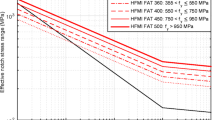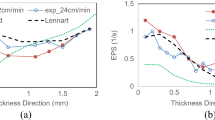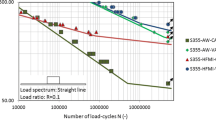Abstract
In this study, the residual stress simulations of the out-of-plane gusset welded joints examined by Leitner et al. (2016) in As-welded and HFMI-treated conditions which are performed by Ruiz (2018, 2019) are reviewed and verified. Based on the reviewed simulation’s results, the changes of residual stress under constant amplitude and compressive spike loads with various stress amplitudes are simulated. Sensitivity analyses of the simulation parameters in stress response simulation are carried out, and recommendations on residual stress relaxation simulation are proposed. From the residual stress relaxation simulation results, the following are found: (1) for constant amplitude cyclic loading cases, the residual stress induced by HFMI treatment shows considerable relaxation. The longitudinal component of the residual stress shows a slight increase when the maximum stress of the cyclic loading is large, about 44.5%; (2) for spike followed by constant amplitude cyclic loading cases, the residual stress shows considerable relaxation. The degree of the relaxation becomes more significant with the increase of spike load and/or the maximum stress in the constant amplitude loading except the longitudinal stress component on the top face. The longitudinal residual stress near top face shows considerable improvement showing around 21% of increment compared with the as-peened condition.
















Similar content being viewed by others
References
Statnikov E, Trufyakov V, Mikheev P, Kudryavtsev Y (1996) Specification for weld toe improvement by ultrasonic impact treatment. IIW Document XIII-1617-96
Marquis GB, Barsoum Z (2013) A guideline for fatigue strength improvement of high strength steel welded structures using high frequency mechanical impact. Proc Eng 66:98–107
Yildirim HC, Marquis GB (2012) Fatigue strength improvement factors for high strength steel welded joints treated by high frequency mechanical impact. Int J Fatigue 44:168–176
Yildirim HC, Marquis GB, Barsoum Z (2013) Fatigue assessment of high frequency mechanical impact (HFMI) improved fillet welds by local approaches. Int J Fatigue 52:57–67
Marquis GB, Mikkola E, Yildirim HC, Barsoum Z (2013) Fatigue strength improvement of steel structures by high frequency mechanical impact: proposed fatigue assessment guidelines. Weld World 57:803–822
Marquis GB, Barsoum Z (2013) Fatigue strength improvement of steel structures by high frequency mechanical impact: proposed procedures and quality assurance guidelines. Weld World 58:19–28. https://doi.org/10.1007/s40194-013-0077-8
Haagensen PJ, Maddox SJ (2010) IIW recommendations on post weld improvement of steel and aluminum structures, IIW Document XIII-2200r4–07, revised February 2010
Mikkola E, Marquis G, Lehto P, Remes H, Hänninen H (2016) Material characterization of high-frequency mechanical impact treated high-strength steel. Mater Des 89:205–214
Morikage Y (2015) Improvement mechanism of fatigue strength of weld joints by hammer peening on base metal. Q J JWS 33:111–117 (in Japanese)
Tsutsumi S, Nagato R, Fincato R, Ishikawa T, Matsumoto R (2017) Numerical and experimental study on fatigue life extension of U-rib steel structure by hammer peening. Proc Weld Soc 35(2):169–172
Ishikawa Tm Matsumoto R, Tsutsumi S, Kawano H (2014) Fatigue strength improvement of rib-to-deck joints of orthotropic steel deck by peening
Tai M, Miki C (2012) Improvement effects of fatigue strength by burr grinding and hammer peening under variable amplitude loading. Weld World 56:109–117
Miyashita D (2011) Relaxation behavior of laser peening residual stressdue to mechanical loading on aluminum alloy. Trans JSME 60:617–623 (in Japanese)
Yildirim HC, Marquis G, Sonsino CM (2016) Lightweight design with welded high frequency mechanical impact (HFMI) treated high-strength steel joints from S700 under constant and variable amplitude loadings. Int J Fatigue 2016(91):466–474
Hara J, Shimoda T, Deguchi T, Mouri M, Fukuoka T, Koshio K, Kano D (2010) A study on fatigue strength improvement for ship structures by ultrasonic peening Part 1, Conference Proceedings of The Japan Association of Ship and Ocean Engineers, 2010S-G12-4 (in Japanese)
Okawa T, Shimanuki H, Funatsu Y, Nose T, Sumi Y (2013) Effect of preload and stress ratio on fatigue strength of welded joints improved by ultrasonic impact treatment. Weld World 57:235–241
Leitner M, Khurshid M, Barsoum Z (2017) Stability of high-frequency mechanical impact (HFMI) post-treatment induced residual stress states under cyclic loading of welded steel joints. Eng Struct 143:589–602
Ruiz H, Osawa N, Rashed S (2019) A practical analysis of residual stresses induced by high-frequency mechanical impact post-weld treatment. Weld World 63:1255–1263. https://doi.org/10.1007/s40194-019-00753-w
Chaboche J-L (1986) Time-independent constitutive theories for cyclic plasticity. Int J Plast 2(2):149–188
Foehrenbach J, Hardenacke V, Farajian M (2016) High-frequency mechanical impact treatment (HFMI) for the fatigue improvement: numerical and experimental investigations to describe the condition in the surface layers. Weld World 60(4):749–755. https://doi.org/10.1007/s40194-016-0338-4
American Institute of Steel and Iron (AISI) (2015) www.steel.org/, 13.11
Lennart J, Van Duin S, Remes H, Osawa N, Kim MH et al (2018) Committee V.3 materials and fabrication technology, proceedings of the 20th International Ship and Offshore Structures Congress (ISSC 2018). Prog Marine Sci Technol 2:143–191
Ruiz H, Osawa N, Murakawa H, Rashed S (2018) Stability of compressive residual stress introduced by HFMI technique, Proceeding of the ASME 2018 37th International Conference on Ocean, Offshore and Arctic Engineering. 4:V004T03A019, https://doi.org/10.1115/OMAE2018-77887
Ueda Y, Murakawa H, Rashwan AM, Neki I, Kamichika R, Ishiyama M, Ogawa J (1993) Development of computer aided process planning system for plate bending by line-heating (repot IV): decision making on heating conditions, location and direction (Mechanics, Strength & Structural Design). Trans JWRI 22(2):305–313
Kim (2017) Numerical simulation of high frequency mechanical impact (HFMI) treatment in fillet welded joints, ISSC’18 Committee V.3 Benchmark
MSC Software (2017) MSC DYTRAN2017 Reference Manual
Mikkola E, Remes H, Marquis G (2017) A finite element study on residual stress stability and fatigue damage in high-frequency mechanical impact (HFMI)-treated welded joint. Int J Fatigue 94:16–29
Leitner M, Ottersbock M, Pubwald S, Remes H (2018) Fatigue strength of welded and high-frequency mechanical impact (HFMI) post-treated steel joints under constant and variable amplitude loading. Eng Struct 163:215–223
Acknowledgements
The authors would like to acknowledge the contribution of all committee members of ISSC (International Ship and Offshore Structures Congress) 2018 V3 Materials & Fabrication Benchmark group: Prof. Lennart Josefson (Chalmers University of Technology), Prof. Heikki Remes (Aalto University) and Prof. Myung Hyung Kim (Pusan National University).
Author information
Authors and Affiliations
Corresponding author
Additional information
Publisher’s note
Springer Nature remains neutral with regard to jurisdictional claims in published maps and institutional affiliations.
Recommended for publication by Commission XIII - Fatigue of Welded Components and Structures
Rights and permissions
About this article
Cite this article
Ruiz, H., Osawa, N. & Rashed, S. Study on the stability of compressive residual stress induced by high-frequency mechanical impact under cyclic loadings with spike loads. Weld World 64, 1855–1865 (2020). https://doi.org/10.1007/s40194-020-00965-5
Received:
Accepted:
Published:
Issue Date:
DOI: https://doi.org/10.1007/s40194-020-00965-5




